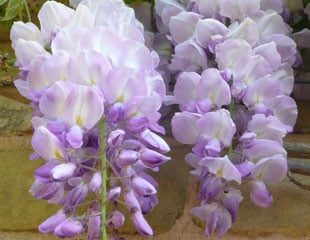
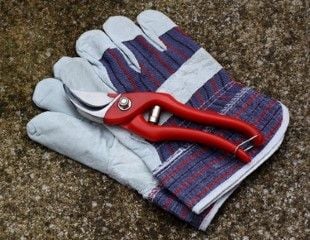
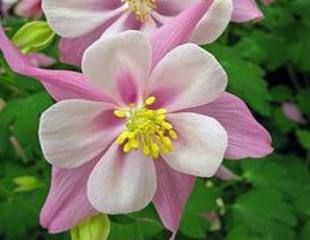
Beginners Guide to Gardening
For whatever reason you have started gardening. Good decision.
For the first time you may be living in a property which has a garden. Alternatively, looking at the outside space you may have decided now is the time to tackle the garden to make something better of it. You may have decided gardening maybe fun. You want to do your best and make the least mistakes, get value for money from the plants and shrubs you buy, and enjoy yourself along the way. All good goals.
Gardening is fun, and not difficult, and you will make mistakes. All gardeners do no matter how long they have been gardening.To get the best reward for your efforts, it is best to start with the basics.
The images above portray simple gardening truths. Not all plants are gardening equals. On the left is Wisteria, a beautiful quintessentially English climbing plant and a bit of devil to grow. The most watched of my videos is " How to get Wisteria to Flower", and this is also the most frequently asked question. (Inevitably this means there are quite a few gardens with non flowering Wisteria in them.)
On the right is an image of Aquilegia, happily one of the gardening world's easiest plants to grow, it's a doddle. So if you are new to gardening, it is best to start with easy to grow plants, or at least some plants which are easy to grow.
If you get stuck, e-mail the Sunday Gardener for help and advice.
Check out help in the Gardening Glossary of Terms.
Also Colour coded to help. All the plants on this website are colour coded to see at a glance which are the easy plants to grow.
A wheelbarrow classification used throughout this website gives an at a glance idea about the plant.
Red Wheelbarrow means it is either hard to grow, requires particular growing conditions or needs a lot of time and attention.
Green Wheelbarrow is the opposite, meaning it is one of the easiest plants to grow.
Amber representing the middle ground. More about Colour coding.



Start With the Easy to Grow plants
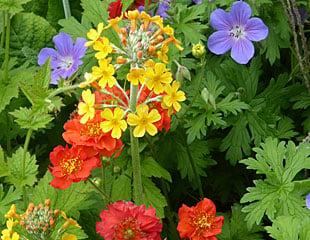
Fact is some plants are just much easier to grow than others. Illustrated is Geranium, an easy reliable plant which returns each year and flowers well. It is teamed up with Primula, another easy garden plant.
There are lots of easy plants and shrubs which can be relied on to flower each year with little attention or maintenance. These are illustrated throughout as Green Wheel barrow plants, and many varieties named and listed also have the RHS award of Garden merit award, which means the variety is endorsed by the RHS as a good variety to grow.
Wisteria, Roses and Clematis look lovely but they are not easy to grow and require a lot of time and pruning skill to get them to grow well and flower. Not everyone has hours of time to spend in the garden, or indeed wants to spend hours nurturing a plant into flower. Take a look at the best 10 easy plants to grow, and Fast Growing Shrubs for more ideas for an easy gardening time.
Right Plant Right Place
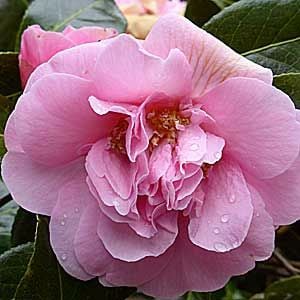
Many plants are quite individual in their preferred planting place. To have the best growing results, it is important to pick the right plant for your growing conditions. There are a large group of easy to grow plants which are not fussy, but there are also some very popular garden plants which are fussy. When these are planted in the wrong conditions they will not thrive.
Different plants suit different growing conditions. For example, there are plants suitable to boggy conditions, others demand dry well-drained soil. Many plants are fully hardy and will withstand the worst of our winters; but equally there are hardy plants which are damaged by chill winds, or winter wet, and a huge group which are not frost hardy at all.
We all know plants like sun, and that some plants will tolerate and grow in the shade, but soil type can also matter. Illustrated right is a Camellia which is a case in point. Camellias belong to a group of plants which only grow in ericaceous or acid soil. Included in this group are Rhododendrons, Azalea, Pieris, Japanese Maple, and Magnolia and they will only thrive on ericaceous soil. If your soil is not acid it is necessary to plant them in a container filled with ericaceous soil. From this example you can see why you need to know put the right plant in the right place. How do you know if your soil is acid? You can either buy a soil testing kit, or sneak a look next door and see what your neighbour is growing.
Looking at your garden and thinking about what to plant, you need information about the soil: acid, alkaline, Clay, Sandy, Silty, Peat, Chalk and Loamy are the main types.
Some further food for thought is to consider the path of the sun through your garden. From this you can work out the areas are the sunniest and warmest, and often the most sheltered. You can plot the shady areas in the garden, and those areas which are colder and more exposed.
Plants are expensive, and plant labels in garden centres are often less than informative. It is worth knowing your garden layout and looking up plants in the library or online to find detailed growing information.
Popular mistakes!
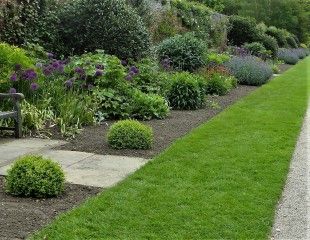
Planting decisions: what to plant where?
A garden, just like the inside of a house, is personal in terms of what plants go into the borders. What I love, you may hate. So without being pejorative, there are a few planting points to consider.
Unless you want such an effect, planting one/or a small number of different plants can look very jumbled and messy. The image right, although of a classic herbaceous type border on a grand scale, has a direct message. Often borders look more effective if they have repeat themes and colours in them. Look closely at the image right and Alliums are themed, silver blue foliage, Nepeta and green shapes; there is a regularity in the border design which tends to work well, even in smaller gardens.
What type of effect do you want to create?
There are all types of garden styles and designs. Cottage garden style is very popular, and traditional. There are also contemporary planting designs using grasses and structural plants. Herbaceous plants die back and disappear over the winter leaving the borders bare. Evergreen shrubs create form and structure, but there is much to be said for the sight of deciduous shrub bursting into bud with new green foliage in the spring. The only real rule is to create the garden as you like it, with a style and planting arrangements that you enjoy, it is just like decorating your house but on the outside.
Not all weeds are created equal- Why weeding is important
Weeding is a bit of a marmite job, love it or hate it but sometimes it needs to be done. Some weeds are much more of a problem than others. The very persistent perennial weeds, if they get a foot hold in your garden, can be a devil to get rid of. Illustrated below right is Horsetail, sometimes (wrongly) called Mare's tail. It is vigorous, spreads like fury and is very hard to remove because its roots are far reaching and as you try to weed it out it snaps off in your hand leaving the roots still in the ground. With this type of weed you really need to get to it as soon as it appears so that it cannot get established. This is the time to get weeding, and usually it needs some chemical enticement to depart.
Contrast with the image left Hairy bittercress (Cardamine histuta) which although a prolific weed, it is very easy removed and has short roots, and is quite benign by comparison.
If something like Horsetail gets established in a border it can be so difficult to eradicate that the only way maybe to clear the border, attack the weed for at least a season and if it shows no sign of re appearing it may be safe to replant. That is a lot of bother, best to get it early.
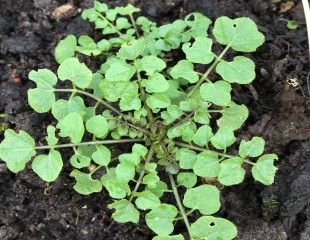
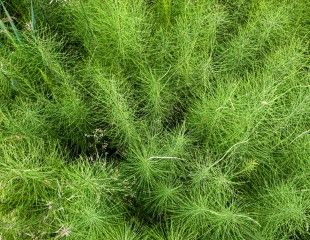
A trick to avoid the weeding
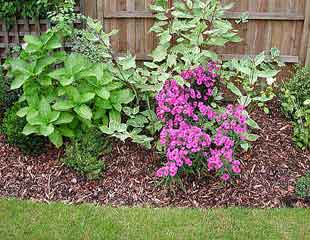
If you dislike weeding, or just don't have the time, one way to suppress weeds is to lay a membrane as you plant. This works best in a new border, but you can cut and patch it into an existing border. Membrane is a woven black plastic membrane which lets water in but because it forms a dark mat, it is effective at suppressing the weeds.
It comes on a roll, and you have to cut holes in it to plant through, and because it is not very attractive, it is usually then covered in bark or another type of mulch. It is particularly suited to shrub borders.
Membrane can restrict the growth of the base of a plant or shrub so it is important to ensure that there is plenty of give and slack around the cut into the membrane to give the plant or shrub room for growth. However, it is very effective in limiting weeding and well worth a thought if you are planting up a new border. The border illustrated in this image has a membrane with bark covering on it.
Growing Vegetables for the first Time
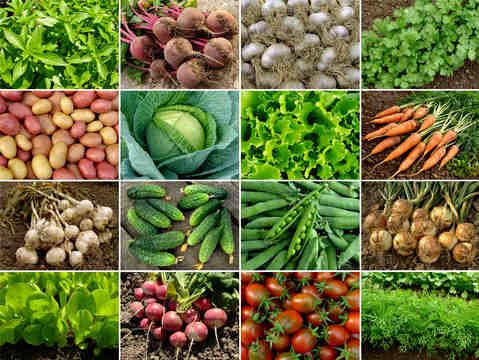
Growing vegetables has become really popular and is a great way to get the fresh veg for the kitchen.
If you are growing veg for the first time it is worth bearing in mind that veg do take up more time than most garden shrubs and plants.
There are plenty of green wheelbarrow veg and a good starting point is to check out Growing Veg Tips aimed at helping the novice gardener start growing veg.
Whatever veg you are thinking of growing, remember almost all vegetables like a sunny spot with good soil. This means you need to sit your veg plot, or veg containers where there is plenty of sun and good drainage.
Pruning - Reasons to be Cautious
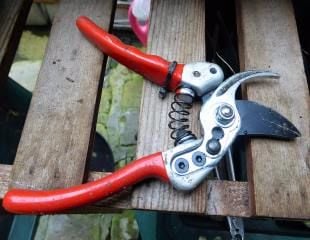
Sometimes when the garden looks messy, it's tempting to get out the secateurs and give it a good cut, prune and general tidy up.
Pruning at the wrong time can cause problems. The good news is pruning at the wrong time will rarely kill a plant or shrub, but it may mean it it does not flower that year, and if it is pruned wrongly each year, it will fail to flower each year. Not a good outcome.
The RHS has 11 pruning groups designed to ensure good growth and that pruning does not cut off the budding flowers, literally. Take Clematis for example, groups 2 & 3 are pruned in February /March and there is enough time after pruning for the plant to put on growth, leaves and produce flowers all in the one season as they flower later in the year from June onwards. Not all Clematis are the same so C. Montana known, as a Group 1 for pruning purposes, flowers early, in April and May. If it was pruned in February the pruning would cut off the branches on which the buds are forming.
The timing of pruning is often centred around when a plant or shrub flowers. This means if you do not know which shrub or plant you have, the first thing is to wait and check when it flowers. You can also always e mail a photo to The Sunday Gardener to take advantage of the plant and shrub identification service. Once you know this you can usually check out the 11 RHS groups and from that decide when to prune. If it doubt always delay pruning until after flowering.
There are general principles of pruning, and some plants such as Clematis and Wisteria with very specific pruning requirements. If it doubt, don’t because it’s very disappointing if you make a mistake, prune to early and the shrub will fail to flower.
Beginners Guide to Gardening Page 1 of 2 (Glossary)
updated 11.12.2023
